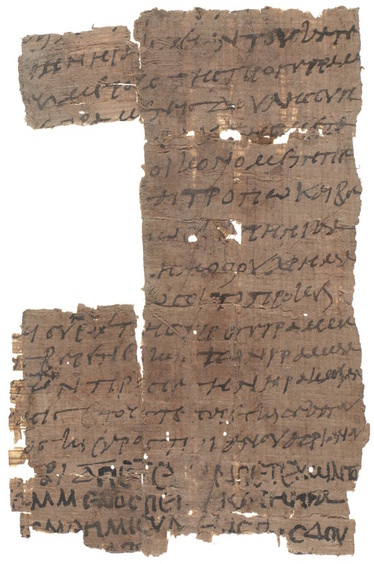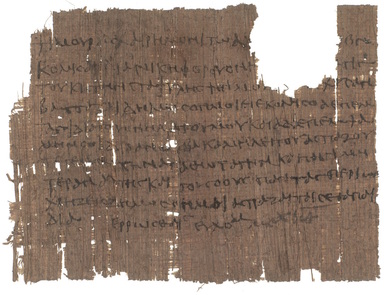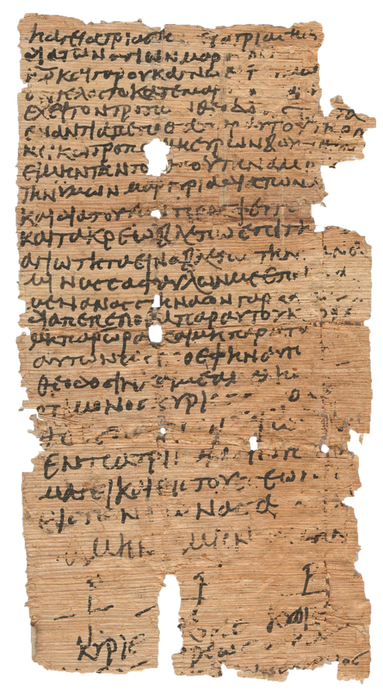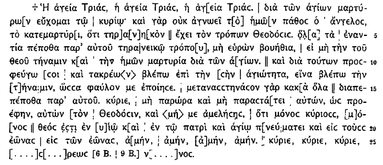 P.Col. 10.254
P.Col. 10.254 But what P.Col. 10.254 and other similar papyri reveal is that women had access to full participation in the economy of Roman Egypt. Herakleia visited the appropriate financial office in person and the transaction was made in her name without any objection. In other words, there seems to have been no social stigma attached to Herakleia's purchase of her own property. The text indicates that Herakleia could "dispose" (i.e., sell, transfer) of Berenike "in whatever way she chooses," underscoring her rights to her property. As the editor maintains, "this is clearly a case of a woman acting independently of men in her own financial interests" (P.Col. 10.254, p. 25). Documentary papyri thus reflect social realities and deepen our knowledge of all sorts of human activity in Egypt, from transportation, business, death, marriage, divorce, and so on.
Notice in the image at the bottom, in a second hand, the subscription of Petechon, from whom Herakleia purchased Berenike. This is an example of a "slow writer," someone who could write his name and a few practiced lines but nothing more. The contract itself was probably written by a private clerk.
| -- -- -- -- -- -- -- -- -- -- 1 ̣ ̣ ̣ ̣[ ̣] ̣[ ̣] ̣[ ̣ ̣ ̣ ̣] ̣[ ̣] ̣ ̣ ̣ ̣ ̣[- ca. 9 -] [κυριεύειν] τὴν Ἡράκλειαν τοῦ κατʼ ἑ- [αυτὸν ἡμίσ]ο̣υς μέρους τῆς προγεγραμ- [μένης καὶ π]ε̣π̣ραμένης δούλης σὺν 5 [ἐκγόνοις καὶ τοῖς π]α̣ρ̣ʼ α̣ὐ̣τῆς μετα- [λημψομένοις καὶ] οἰκονομεῖν πε- [ρὶ αὐτῆς ᾧ ἐὰν αἱρῆ]τ̣αι τρόπῳ. καὶ βε- [βαιουμένης δημο]σ̣ιώσει ὁπηνίκα [ἐὰν αἱρῆται κατὰ] δ̣ημ̣οσίου χρημα- 10 [τισμοῦ καὶ βεβα]ι̣ῶ σοι τὸ προκεί- [μενον ἥ]μισυ \μέ/ ρος τῆς προγεγραμμέ- [νης δούλ]η̣ς Βερενεί̣κης, τῶν γραμμα- [τικῶν] \[καὶ τ]ελῶν/ [ὄν]τ̣ων πρὸς σὲ τ̣ὴν Ἡράκλειαν. [κυρία ἡ π]ρ̣ᾶσις. ἔτους τεσ̣σαρεσκαιδεκάτου 15 [Αὐτοκράτορ]ος Καίσαρος Τρα̣ιανοῦ Ἁδριανοῦ [Σεβαστοῦ] Τ̣ῦβι δ (hand 2) Πετεχ̣ῶ̣ν Πετεχῶντο(ς) [ὁ προγεγ]ρ̣αμμένος πέπ̣[ρα]κα τῇ Ἡρα- [κλ(ε)ίᾳ τὸ κα]τʼ ἐμὲ ἥμισυ μέρος τῆς δού- [λης Βερενείκης κ]α̣ὶ̣ ἀ̣π̣έ̣[σχον τὰ τ]ῆ̣ς̣ [τιμῆς] -- -- -- -- -- -- -- -- -- -- | "[Petechon acknowledges that from now on] . . . Herakleia is to own and be master of her half share of the aforesaid sold female slave, with her descendants and her successors, and to dispose of her [the slave] in whatever way she chooses. The title of the slave being guaranteed, she shall publish it whenever she chooses in accordance with a public document, and I guarantee to you the indicated half share of the aforesaid female slave Berenike, the scribal fees and taxes being at the charge of you, Herakleia. The sale is normative. In the fourteenth year of Imperator Caesar Trajanus Hadrianus Augustus, Tybi 4 [= 30 December 129]. (second hand) I, Petechon son of Petechon, have sold to Herakleia my half share of the female slave Berenike and I have received the . . ." |



